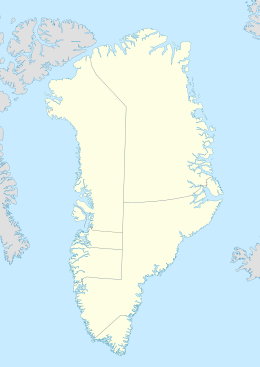Kiatak
Native name: Kiatak (Kujata) | |
|---|---|
 Aerial view of Kiatak Island | |
 Map of Northumberland Island | |
| Geography | |
| Location | Baffin Bay, Greenland |
| Coordinates | 77°23′N 71°56′W / 77.383°N 71.933°W |
| Area | 277 km2 (107 sq mi) |
| Area rank | 26th largest in Greenland |
| Highest elevation | 1,030 m (3380 ft) |
| Highest point | Nalungiussaq |
| Administration | |
| Municipality | Avannaata |
| Demographics | |
| Population | 0 (2023) |
| Pop. density | 0/km2 (0/sq mi) |
| Ethnic groups | none |
Kiatak or Northumberland Island (Danish: Northumberland Ø), also known as Kujata, is an island off the coast of northern Greenland.[1]
Geography
[edit]This relatively large island is part of a small group formed by Kiatak, Herbert Island and Hakluyt Island.[2] The latter is the smallest of the group and lies off Kiatak's western shore. The islands lie off the Inglefield Fjord, between the Murchison Sound to the north and the Hvalsund to the south.[3]
Important Bird Area
[edit]The island has been designated an Important Bird Area (IBA) by BirdLife International because it supports a breeding population of some 2.5 million pairs of little auks, as well as other seabird species.[4]
History
[edit]The island was inhabited at the time of Robert Peary's Greenland expeditions in 1886 and 1891–1897.[5]
 |  |
See also
[edit]Bibliography
[edit]- Peary, Robert (1898). Northward over the great ice : a narrative of life and work along the shores and upon the interior ice-cap of northern Greenland in the years 1886 and 1891-1897, with a description of the little tribe of Smith Sound Eskimos, the most northerly human beings in the world, and an account of the discovery and bringing home of the Saviksue or great Cape York meteorites. New York, NY: F.A. Stokes Company. Book Viewer
References
[edit]- ^ Kiatak at GEOnet Names Server
- ^ "Inglefield Bredning". Mapcarta. Retrieved 26 March 2019.
- ^ 1:1,000,000 scale Operational Navigation Chart, Sheet B-8, 3rd edition
- ^ "Northumberland Island". BirdLife Data Zone. BirdLife International. 2021. Retrieved 28 November 2021.
- ^ Robert Peary, Northward over the great ice, p. 103


 French
French Deutsch
Deutsch
